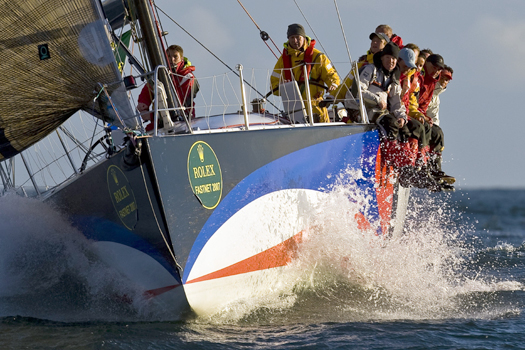Displaying items by tag: Round Ireland
Go LulaBelle! How Ireland Won The Round Britain & Ireland Race
#rorcsrbi – For twelve days, Ireland's sailing and maritime community followed with bated breath while the fortunes of Liam Coyne and Brian Flahive with the First 36.7 Lula Belle waxed and waned in the storm-tossed 1802-mile RORC Sevenstar Round Britain & Ireland Race. Last Saturday, they triumphed, winning the two-handed division and two RORC classes in this exceptionally gruelling marathon. W M Nixon delves into the human story behind the headlines of success.
It used to be said that Irish seamanship was the skilled and stylish extrication of the vessel from an adverse and potentially disastrous situation in which she and her crew shouldn't have been next nor near in the first place.
While we may have moved on a bit from that state of affairs with a less devil-may-care approach to seafaring, there's no escaping the fact that this morning we can now look back at two remarkable Irish victories in topline international offshore events in recent years in which both crews overcame major setbacks and situations, rising above very adverse circumstances which could well have deterred sailors from other cultures where the philosophy is not underpinned by the attitude: "Ah sure lads, things aren't good. Not good at all. But let's just give it a lash and see how we go".
It was seven years ago when a full entry list of 300-plus boats was slugging westward down the English Channel in the first stages of the Rolex Fastnet Race 2007. Already, the start had been postponed 24 hours to allow one severe gale to go through. But in an event still dominated by the spectre of the 15 fatalities in the storm-battered 1979 race, most crews were hyper-nervous about another gale prospect, and by the time the bulk of the fleet was in the western English Channel, many succumbed to the allure of handy ports to lee such as Plymouth, and in those early days of the race something like 48% of the fleet retired.
But aboard Ger O'Rourke's Cookson 50 Chieftain out of Kilrush on the Shannon Estuary, they were well into their stride. That year, the boat had already completed the New York to Hamburg Transatlantic Race, placing second overall. But owing to her Limerick owner's quirk of never confirming the boat's entry for the next major event until the current one is finished, they found themelves only on the waiting list for that year's already well-filled Fastnet Race entry quota.
Chieftain was 46th on that list. Yet while those who had made an early entry fell by the wayside, steadily this last-minute Irish star rose up the rankings. With three days to go, Chieftain got the nod. They went at the racing after the delayed start as though this had been a specific campaign planned and carefully executed over many months with a full crew panel, instead of a last-minute rush where crew numbers were made up by a couple of pier-head jumpers who proved worth their weight in gold.
Yet then, as the new strong winds descended on the fleet as the group in which Chieftain was already doing mighty well was approaching the Lizard Point, the troubles started, with gear failing and boats pulling out left and right. But the Irish boat was only getting into her stride. A canting-keeler, she could be set up to power to windward in a style unmatched by bigger craft around her. Approaching the point itself in poor visibility to shape up for the fast passage out to the Fastnet Rock with even faster sailing, things looked good. And then the entire electronics system aboard went down, and stayed down.
Here they were, not even a third of the way into a race which promised to be rough and tough the whole way, but a race in which they would at least have been expecting know their speed, performance and position down to the most minute detail. Instead, they were in an instant reduced to relying on a couple of tiny very basic hand-held GPS sets, and paper charts.
Ger O'Rourke's Chieftain sweeps in to the finish at Plymouth to win the 2007 Rolex Fastnet Race overall
Those paper charts were little better than pulp by the end of a very wet race in an inevitably extremely wet but searingly fast boat. But they did get to the end, and with style too. They won overall and by a handsome margin. It was the first-ever Irish total victory in the Grand National of Ocean Racing. The owner-skipper had to go up the town to buy himself a clean shirt for the prize-giving in the Plymouth Guildhall.
Yet when Ger O'Rourke's Chieftain swept into Plymouth and that triumph just over seven years ago, the boat was in much better racing shape than Liam Coyne's First 36.7 Lula Belle when he and Brian Flahive completed the final few miles back into Cowes around midday last Saturday to finish the 1802-mile Sevenstar Round Britain & Ireland Race.
Lula Belle had many gear and equipment problems after an extreme event where the natural pre-start nervousness had been heightened by a reversal by the Race Management of the originally clockwise course as the 10th August start day approached. It would have been folly to send the fleet westward into storm force westerlies in restricted waters. Eastward was the only sensible way to go.
Then the arrival of the remains of Hurricane Bertha – which seemed to be finding new vigour – led to new tensions with the start being postponed from midday Sunday to 0900 Monday. It was disastrous from a general publicity point of view. But it would have been irresponsible to send a fleet of boats – some of them mega-fast big multihulls – hurtling towards the ship-crowded narrows of the Dover Straits beyond the limits of control in a Force 11-plus from astern.
Even when they did race away, it was with a Force 8 plus from the west, with the Irish crew recording 42.5 knots of wind aboard Lula Belle (and from astern at that), before they lost all their instruments from the masthead on the first night out. For a double-handed crew, that was a very major blow. Two-handers are allowed to use their auto-pilot, and if all the wind indicators are functioning in proper co-ordination with it, then the boat can sail herself along a specific setting on the wind. It's as good having at least one extra hand – and a skilled and tireless helmsman at that - on board.
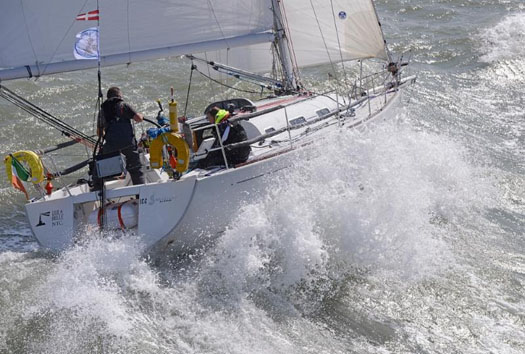
Lula Belle on her way out of the Solent with 1800 miles to race and everything still intact. Photo: Rick Tomlinson
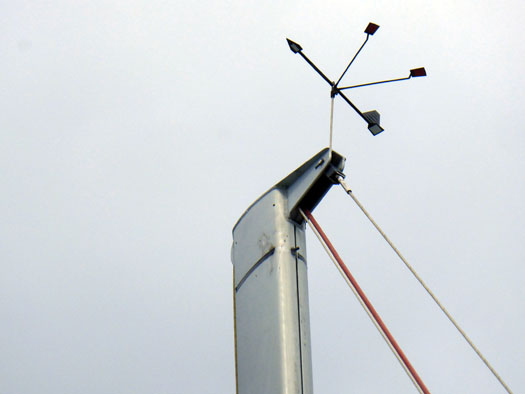
There it was – gone. After the first night at sea, Lula Belle's masthead was bereft of everything except an often defective Windex. Photo: W M Nixon
Fortunately the auto-pilot itself was still working on its own, and they became well experienced in setting the boat on course and then trimming the sails to it in a continuous process which worked well except when the seas were so rough and irregular that they had to hand steer in any case, albeit with the apparent wind indicated only by the sole survivor of the masthead units, the little standard Windex. But it must have been damaged when everything else was swept away, as from time to time it jammed. When that happened, the only wind indicators available to the two men were the Sevenstars battleflag on the backstay, the tell-tales on the sails, or a moistened finger held aloft, as neither were smokers.
Despite this, they made their way north through the North Sea and all round Scotland and its outlying islands and right down the western seaboard of Ireland as far as the Blaskets before things went even more pear-shaped. In fact, the wheels came off.
Their ship's batteries had been showing increasing reluctance to hold power, essential for the continuing use of the autohelm and the most basic need for lighting and any still-usable electronic equipment including the chart plotter. But thanks to a trusty engine battery, they could start the motor to bring the ship's batteries back up to short-lived strength. Yet while approaching the Blaskets, the engine refused to start, and nothing they could do would coax it back to life. Inevitably they lost power, and for the final 495 miles of the race – the equivalent of 78% of a Fastnet Race - the boat was sailed and navigated entirely manually, with the required navigation lights provided by modified helmet lamps.

The chart plotter shows only too clearly where power was lost completely just north of the Blaskets. Photo: W M Nixon
Yet they finished well last Saturday, around noon on August 23rd after twelve days racing. They won the two-handed division overall, they won Classes IV & V, and they placed sixth overall in a combined fleet in which big boats with a strong element of professional crewing dominated. So who are Liam Coyne and Brian Flahive, and what about Lula Belle, the heroine of the tale?
Afloat.ie caught up with them on Thursday morning in Dun Laoghaire marina, where they'd got home an hour or so before dawn to grab a quick sleep of a few precious hours before awakening to more sunshine than they'd experienced for a long time, as the Round Britain & Ireland was raced across an astonishingly sunless sea. As for the 450-mile passage home to Dublin Bay, it had been achieved through mostly miserable weather and an enforced and brief stop in Plymouth to try to get a final solution to the continuing electric problems, which had defeated the finest minds in Cowes.
But such hassle fades when the return home is completed, and the Lula Belle crew were in great form. They complement each other. Brian Flahive is from Wicklow and he's a studious, thoughtful type. He turned 31 just three days after the win, making it his best birthday ever, and a fitting highlight in a sailing CV which continues to develop, and began with local sailing and training courses with Wicklow Sailing Club after his sister Carol had acquired a Mirror dinghy.
Since then, Carol's seagoing has taken a slightly unexpected turn as she found her vocation in the lifeboat service, and that is now her main interest afloat - she is a helm on the Wicklow lifeboat. But her younger brother Brian was soon hooked on pure sailing, and from the Mirror he soon went on the 420s where his enthusiasm was noted by local keelboat owners, who in turn recruited him aboard, and soon he was noted by those assembling offshore racing crews too.
When you've talent, enthusiasm and time available, the word soon gets about in the limited recruiting pool available to Ireland's offshore racing folk. Soon, young Flahive was spreading his wings with his home port's biennial Round Ireland race, and participation in Irish Sea Offshore Racing. He proved adept at and interested in two-handed sailing in particular, and soon got to know another relative newcomer to the Irish Sea offshore racing scene, Liam Coyne.
Liam Coyne is 47, and something of a force of nature. There's a mischievous twinkle to his eye, but there's a very serious side to him too, even if – as when he admits he's extremely competitive – it's done in the best of humour. He's from Swinford in County Mayo, where any knowledge of boating might relate to the big lake of Lough Conn nearby. But as he left Mayo for the USA just as he was turning 20, his passionate sailing involvement has been entirely generated during his more recent life in Dublin.
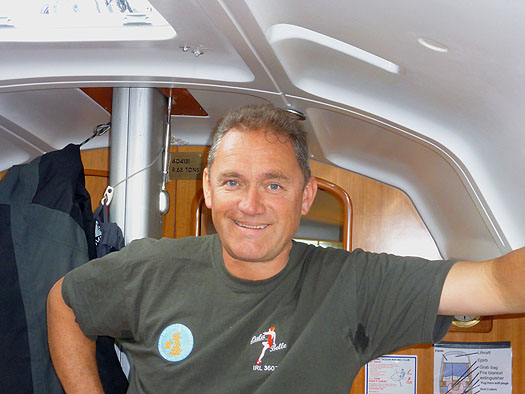
There's a mischievous twinkle, but Liam Coyne makes no secret of his competitive nature. Photo: W M Nixon
Back in the 1980s, well before Australia took off as the destination of choice for energetic and ambitious young Irish people, America was still the Land of Dreams. Coyne's teacher of English in Mayo was so sure of this that one of his courses was built entirely around the USA's immigration examination. He did a good job, young Coyne made the break, and he started to fulfill his ambition of getting to all the American states by spending time – sometimes quite a lot of it – in 26 of the States of the Union. Eventually with a winter approaching, he found the building site he was quietly working on in Boston was due to close completely for the colder months. But he managed to swing a job selling Firestone tyres (sorry, "tires") from the local agent's shops. It was a union created in heaven. Liam Coyne and tyres – the bigger the better – were made for each other.
He prospered in the tyre business in Boston and enjoyed his work, but there was always the call of home and a girl from Swinford who had qualified as a teacher. So he came back to Ireland in 1998, set up in the tyre business in Leinster, married the girl and settled down in south Dublin to raise a family.
Came the boom years, and the tyre business prospered mightily. Liam Coyne Tyres had five depots and employed 48 people. He was mighty busy, but seeking relaxation. So on the October Bank Holiday Monday in 2005, he and his wife went to the Used Boat Show at Malahide Marina and by the time they left, Alan Corr of BJ Marine had sold them a handy little Beneteau First 211, their first boat.
His knowledge of boats and sailing was rudimentary to non-existent. His maiden voyage, the short hop of 12 miles from Malahide to his recently-joined new base at Poolbeg Y& BC in Dublin port, took all of 14 hours as the tyro skipper battled with the peculiarities of tide and headwinds, happily ignoring the potential of the little outboard engine on the transom even though, as Alan Corr cheerfully told him later, it could have pushed the boat all the way to Arklow in half the time.
But he was enchanted by this strange new world, and the camaraderie of the sailing community as expressed in Poolbeg. He made a tentative foray into the club's Wednesday night racing, and was even more strongly hooked. But even though those Wednesday club races in the inner reaches of Dublin Bay were such fun that from time to time he still returns to race with his old clubmates at Poolbeg, he knew that his ambitions would dictate a move into a larger boat, and the bigger world of Dublin Bay sailing. So when the next Dublin Boat Show came along, he went to it and ended up buying a Bavaria 30 from Paddy Boyd, who was marketing Bavarias in the interval between being Secretary General of the Irish Sailing Association, and Executive Director of Sail Canada.
Paddy Boyd wised him up to the Dun Laoghaire sailing scene, and which club he might find the most congenial while being suited to his ambitions. For Liam Coyne was discovering offshore racing, and particularly the annual programme of the Irish Sea Offshore Racing Association. He liked everything about ISORA, the friendships, the willingness to help and encourage newcomers, and the pleasant sense of a mildly international flavour between the English, Welsh and Irish contingents.
One of his fondest memories is of taking his Bavaria 30 across to North Wales for the annual Pwllheli-Howth race which traditionally rounds out the season, and is often blessed with Indian summer weather. As he headed away from Dublin Bay, he suddenly realised it was the first time he had ever left Ireland under his own command. All previous exits had been on scheduled ships or planes. It was a very special moment.
Yet while he treasures the memory of such special moments, it wouldn't be Liam Coyne if he wasn't moving on. He'd relocated his base of operations to the bigger scene of the National Yacht Club and Dun Laoghaire, and developed his taste for double-handed offshore racing and its link to a group whose only common denominator seemed to be that many of them shared an enthusiasm for racing vintage Fireballs in Dun Laoghaire harbour in the winter.
But in the summer, keelboat offshore racing with just two on board was increasingly their main line, and he was soon on terms of friendship with the likes of Brian Flahive, Barry Hurley and others, while the double-handed class in events like the Dun Laoghaire-Dingle, the Round Ireland, and the Fastnet itself were coming up on the radar.

The newly-acquired First 36.7 which became Lula Belle greatly broadened the scope of Liam Coyne's offshore racing. Photo: W M Nixon
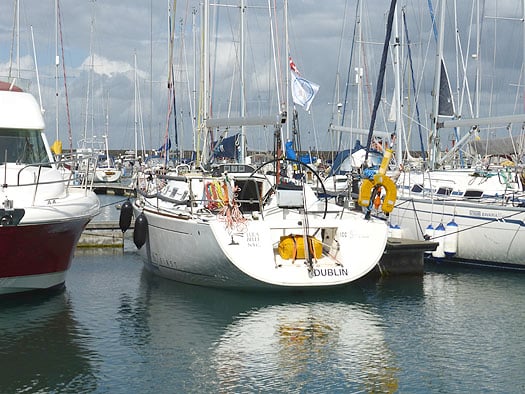
The First 36.7 is of a useful size to be a very pleasant family cruiser, but Lula Belle has been a multi-purpose boat since Liam Coyne bought her, with the emphasis on double-handed offshore racing, and the longer the course, the better. Photo: W M Nixon
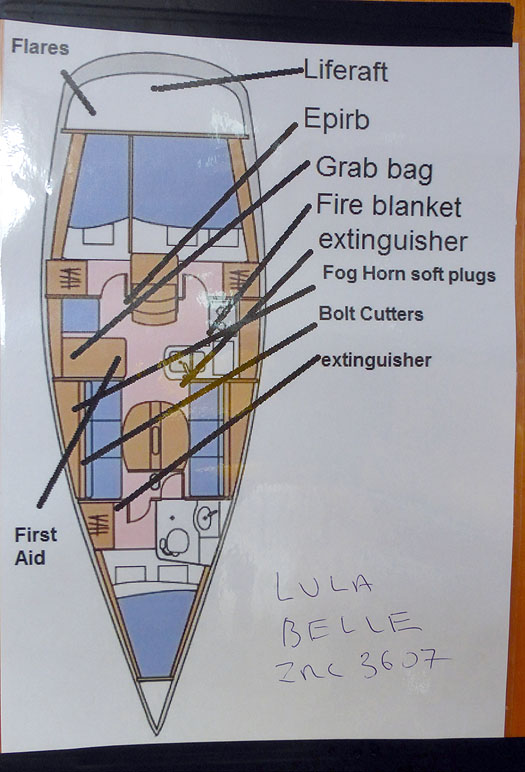
Lula Belle's layout - the accommodation of a cruiser/racer with extras installed for serious offshore racing, but for proper cruising they'd also be required. Photo: W M Nixon
Having made his mark offshore partnered with Brian Flahive on the Bavaria, he very quickly moved up to the almost-new First 36.7 Baily, bought from Tom Fitzpatrick of Howth. His name of Lula Belle for the boat was inspired by a recently-deceased aunt who had invariably addressed all of his sisters as "Lula Belle" when requesting something like a cup of tea. It's certainly a distinctive name, and it was beginning to feature regularly in short-handed and fully-crewed offshore racing reports when Ireland fell off the economic cliff around 2007.
The tyre business was hit particularly hard, for they're items whose replacement people can try to avoid by shifting used tyres around on and between vehicles to get the last piece of tread usable. But fortunately, one of his key contracts was in the heavy industrial area, where they use tyres so big your everyday motorist has no notion of them, yet legal safety working requirements dictate their regular replacement.
Despite this, at one stage his fine workforce of 48 had become effectively just two, while three of the five depots were closed. "I can tell you" he says, "there were times when we were glad enough the wife had kept her teaching job". And they were raising a family, eventually with three kids with a much-loved holiday home at Enniscrone in southwest Sligo. Then too he had this 36ft racing boat too. Yet all his fine assets and the value of the family home in Dublin had effectively been slashed by at least 50% and often more.
But somehow he kept going, and he even continued to race offshore. By this time one of the leading figures in the Irish short-handed sailing scene, Barry Hurley, had moved to Malta, and when he was recruiting crew for a friend with a Grand Soleil 40 for the annual 620-miles Middle Sea Race from Valetta in late October, he filled four berths with able-bodied crew from Dublin including Barry Flahive and Liam Coyne.
That race brought something of another epiphany to match that moment of pure joy at realizing he was skippering his own boat out of Irish waters for the first time. They'd come through the Straits of Messina eastward of Sicily, and next turn of the course was the volcanic island of Stromboli. It was a blissfully warm summer's night, and Liam was at the helm in just shorts and shirt, enjoying the sail and revelling in the race.
Stormboli was gently erupting just enough to show it was there, and ideal to be a mark of the course. "I'll tell you," says Liam, "it was a very long way indeed from your usual October night in Swinford". The magic of the moment reinforced his ambition to see his business through the recession and out the other side, which he has now achieved with busy depots in Navan and Dublin, and staff back above the twenty mark. Yet oddly enough, it also reinforced a shared ambition with Brian Flahive to do the four-yearly Seven Stars Round Britain & Ireland Race, when conditions up in the northern seas off Shetland and across towards the Faroes can often make an October night in Swinford seem like the balmy Mediterranean by comparison.
But the idea just wouldn't go away, and they put down their names for the 2014 race. With the economy coming out of intensive care and two good managers running his two depots and the three kids though the very young stage, Liam Coyne felt he could take off the time for this major challenge. But even so it was done without any form of shore management support, and in fact he managed to mix it with some family cruising – to which the boat is surprisingly well suited – by taking his young son Billy (10) and daughter Katie (8) along with him for a leisurely delivery to Cowes by way of many of the choice and picturesque ports along the south coast of England, where his wife and the youngest child joined the party to see them off.
That was in the last of the summer. By the time the starting date was upon them, it was as if a giant and malevolent switch had been activated. The weather was horrible, and even when Bertha had finally grumbled along on her way, it was anticipated that the rush of bitterly cold north winds she'd drag down from the Arctic in her wake would be every bit as unpleasant.
Then came the complete reversal of the course, and the postponement of the start. For a crew who were being their own shore managers and technical support team, it added a last minute mountain of research work on the shape the weather might be when they finally got away, and all the mental strains of waiting overnight for the start. As the lowest-rated boat in the entire fleet, they may have had the consolation of knowing that if they finished with just one boat behind them then they wouldn't be last on corrected time. But by being the low-rater, they would probably finish so long after everyone else that any general celebration would be long over.
That said, when a double-handed team have already successfully bonded, they're better at withstanding the strain of an enforced wait for a delayed start than a larger crew. I can remember only too well when the RORC Cowes to Cork race of 1974 was postponed for ten hours by the then RORC Secretary Mary Pera. A Force 10 sou'wester was making the Needles Channel a complete maelstrom on the spring ebb, but it was forecast soon to ease, so we were to be sent off on the evening ebb.
To get through the wait, it seemed best to stay well away from the boat and have a quiet day if at all possible. But aboard the 47-footer on which I was sailing, there were action men who decided it was time for a party lunch. So although I slunk away alone up the back streets of Cowes (Kensington-on-Sea it was not), and found a little café where the owners were persuaded to provide lunch of boiled potatoes and steamed fish instead of the usual nausea-inducing fish'n'chips, back on the waterfront others meanwhile had different ideas. A massive former rugby international in our crew decided the best way to pass the time was a champagne reception in one of the Cowes clubs followed by a bibulous lunch, and he persuaded several shipmates to join him, though they were circumspect in their consumption while he went at it as though it would be the last festive lunch in his life.
When we finally got racing the wind had indeed eased, though things were still rough enough in the Needles Channel, where we slammed into a head sea with such vigour that the Brookes & Gatehouse speedo impellor – normally a particularly stiff-to-move bit of equipment – was shot into its hull housing so totally we assumed it had broken entirely. It took a few seconds to realize what had happened, and it worked again happily enough once it had been pushed back into working position with the usual robust heave.
However, our mighty rugby forward was not so happy. He was not a happy budgie at all. The news is that, though you may be battering along noisily but successfully with endless bangs and squeaks and groans of one sort or another, when an international rugby forward of classic size gets massively seasick, a new dimension enters the sound and vibration scene - it's as if the entire boat is shuddering from end to end.
But enough of that. In Cowes on the morning of Monday August 11th 2014, it was still blowing old boots from the west , but they tore away downwind like there was no tomorrow. And for some, as far as racing was concerned, there wasn't. Any tomorrow, that is. There were several overnight retrials that set out to be temporary but became permanent. Aboard Lula Belle, however, they were still going strong, but after recording that gust from astern of 42.5 knots (which meant it was pushing 50), the masthead broccoli decided it had had enough, and made its exit.
Some time long before the race, Liam had decided he'd ensure the minimum use of power by having a LED tricolour masthead light, and a technician had been sent aloft to fit it. But that first night, it took off on its own, but taking much else with it, and leaving a beautifully clean masthead, but damn all information for those down below other than a Windex with an increasing tendency to jam.
And already the sails were suffering, for although their gybes were hectic enough, they didn't have to worry about check-stays or runners. But the downside of that was the well-raked spreaders, which helped support the mast in the absence of any aft support rigging other than the standing backstay. The inevitably prominent upper spreader-ends were chafing holes in the mainsail which, despite repairs, were enormous by the finish.
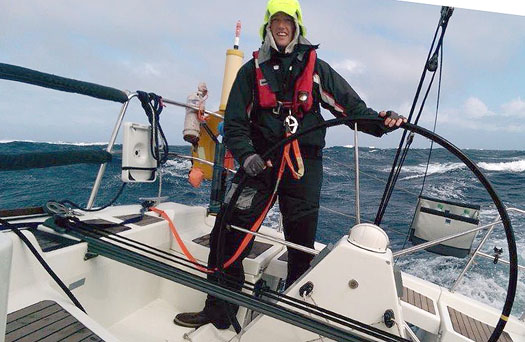
Speed at sea – Brian Flahive on the wheel as Lula Belle puts in the kind of sailing which knocked off 200 miles a day. Photo: Liam Coyne
But they blasted on, roaring on a reach up through the North Sea with Lula Belle doing mighty well, as the more extreme boats such as their closest rival, the Figaro II Rare, weren't quite getting the conditions to enable them to fly, whereas old Lula Belle was knocking off 200 miles in every 24 and saving her time very nicely.
North of the English/Scottish border, the strong winds drew ahead. The forecast, however, was for westerlies, so some boats in front laid markedly to the westward looking for them. But Coyne and Flahive sailed a canny race. What they knew of the weather maps suggested very slow-moving and messy weather systems with lots of wind. And from ahead. They reckoned the prospect of westerlies was just too good to be true. And they were right. On the entire leg up to Muckle Flugga, the most northerly turn, they never strayed more than five or six miles from the rhumb line, and thus they sailed the absolute minimum distance, albeit in very anti-social conditions, to get to the big turn.
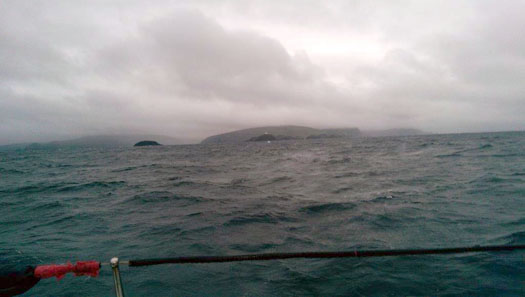
The sunless sea, with Lula Belle getting past Muckle Flugga on Shetland, the northerly turning point of the RB & I Race, and the sky promising plenty of wind Photo: Liam Coyne
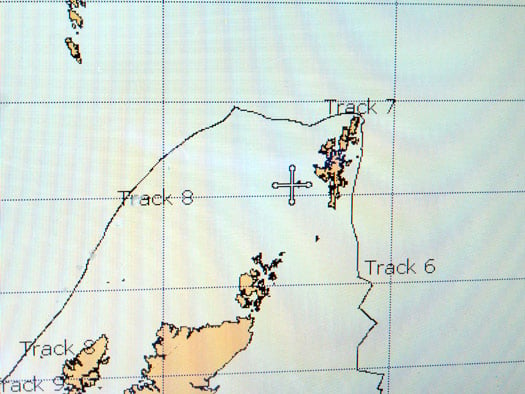
The win move. Although Lula Belle had taken a conservative route northward, once they'd rounded Muckle Flugga they took a flyer to try to get on the favoured side of a slow-moving yet very intense low. The plan succeeded, but they'd to go almost halfway to the Faroes for it to work. Photo: W M Nixon
By this time the faster boats had got back into a substantial lead, but here the situation suited the Irish duo. Those in front went battering and tacking into a fierce sou'wester, trying to get nearer the next turn at St Kilda. But the Irish boat's cunning scheme was to slug directly westward once they'd rounded Muckle Flugga, and not tack until they'd some real prospect of being in the harsh northerlies which they knew to be somewhere out beyond the very slow-moving low pressure area.
Thus they ended up midway between the Shetlands and Orkney to the southeast, and the Faroes to the northwest. As Liam Coyne drily puts it: "When you take a flyer like this and it works, it isn't a flyer any more – on the contrary, it's the only way". What they didn't know was that the boats trying to batter their way past the Outer Hebrides and down towards St Kilda had taken such a pasting that their immediate rival Rare had made a pit stop to rest up in the Shetlands, and others dropped out "for a while" only to find it had become a matter of retiring from the race.
But Lula Belle, having cast the dice to go west, had no option but to keep going, as she was nearly 50 miles west of the Rhumb Line, and more a day's fast sailing from any shelter. By this time, the Scottish forecasters had up-graded their gale warnings to severe storm Force 10. But thanks to their pluck in going west, Coyne and Flahive were up towards the northwest corner of the low, whereas the opposition were down in the southeast quadrant where the winds are usually significantly stronger.
Nevertheless at the change of the watch they shortened sail to the three-reefed main and the storm jib, even though the wind had fallen right away. Brian went off watch and then returned on deck after some sleep to find Liam had become becalmed, and had been so for some time. The centre of the low was passing straight over them. Now it was only a matter of time before the new wind came out of the north.
When it did it was nasty and cold, and the sea became diabolically rough and confused. But it was a fair wind, and they made on as best they could through the short northern night to close in on St Kilda. It was sunrise when they went past that lonely sentinel, and for once there was briefly sunshine to prove it, but it was watery bad weather sunshine as they settled in for the long haul to Ireland.
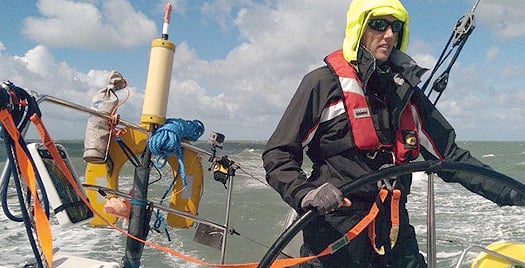
A great fair wind at last, but it was so very very cold despite some sunshine. Photo: Liam Coyne

Early morning as they pass St Kilda, with Lula Belle well placed in the race and her closest but higher-rated rivals astern. Photo: Iiam Coyne
By this stage the boat was very much their home, and they were both in good spirits. Despite the expectation of being in race mode for at least ten days and probably much more, they hadn't anything too much in the way of special easy-made instant food. When asked who had organized their stores and how they had been procured, Liam responded: "I just went to Tesco before the race, and filled her up. It's very easy when you've only two. I've had to do the stores for the boat with a crew of eight, and it's a pain in the neck".

Getting an omelette just right is tricky at the best of times, yet this masterpiece was created aboard Lula Belle off the coast of Donegal in 30 knots of wind. Photo: Liam Coyne
As for living aboard, they used the two aft cabins for sleeping, with hot bunking dictated by which was the weather side. In cruising mode, the First 36.7 is a very comfortable boat, but in racing things tend to get put behind the lee-cloth on the weather settee berth in the saloon, for the fact is the boat is designed to be raced with a crew of 7 or 8, and she tends to be a bit tender without six bodies on the weather rail.

Post-return temporary disorder in Lula Belle's saloon on her arrival back in Dun Laoghaire after sailing nearly 3000 miles in all since she'd last been in her home port. Though Brian (left) and Liam used the aft cabins for the short off-watch periods of sleep, the lee cloths on the settee berths were kept up to provide ready stowage for loose gear, preferably on the weather side. Photo: W M Nixon

Having the toilet on the fore-and-aft axis is very convenient at sea. And having an "extra-easy-cleaned" compartment is a real boon for hygienc. As for the funnel and hose, that's essential in a men-only boat in racing mode. Photo: W M Nixon
To my mind, one of the best things about the accommodation is the heads (toilet if you prefer). Some folk might think the compartment is too compact, but the loo is aligned fore and aft, so there simply isn't the room to fall about when using it. With the fore and aft alignment, security and comfort is guaranteed at those special private moments. It should be a law of yacht design that any boat which is going to be taken further than half a mile offshore is designed with a fore and aft loo.
Such thoughts would not have been forefront in the minds of Lula Belle's crew as they set the A3 spinnaker for the long run to Black Rock off the Mayo coast. Inexplicably, and as evidence of their stretched shoreside management support arrangements, they'd failed to bring along a new Code Zero spinnaker from sailmaker Des McWilliam. They'd gone for it despite it putting three extra notches on their rating, but it was nowhere to be found. After the race, it was discovered among a pile of 20 sails in Liam's Dublin office. But out in the lonely ocean southwest of St Kilda, it wasn't there when it was needed.
Yet it was soon needed even more. The smaller sail that was put up simply disintegrated after a brief period of use. It was inexplicable, but reasons weren't important just then, they were now down to just two spinnakers, and a very long way to go downwind to the finish.
So they nervously got out the A4, and soon it was up and drawing and Lula Belle was back in business, sailing fast for Ireland. Liam went below for a much-needed kip, and a sudden squall over-powered the boat. By the time he got back on deck she'd broached completely and the sail was shredded. They were down to just one spinnaker, and one in very dodgy condition at that. To add to their joys, in a crash gybe the mainsheet carriage disintegrated and they'd "ball bearings, it seemed like hundreds of them, all over the place...."
So there they'd been, passing St Kilda and knowing that, despite the lack of sailing instruments, they couldn't have done the leg from Shetland any better, and more importantly knowing from Yellowbrick that Rare was now well astern. Yet here they were now, only a few hours on the way, and they were down to one spinnaker and a jury-rigged mainsheet arrangement and a long way to go and the weather starting to suit Rare. Could it get any worse?
It did. Approaching the Blaskets, as usual the ship's batteries were draining with unreasonable speed. But the engine, when called upon, was dead. Dead as a dodo. It turned over but just wouldn't start. They knew that in very short order they'd be even further cut off from the outside world than they were already, with no chart plotter and without even the comfort of Yellowbrick to tell them how they stood in relation to the opposition. No autohelm whatever, either. And they'd 495 miles still to sail.
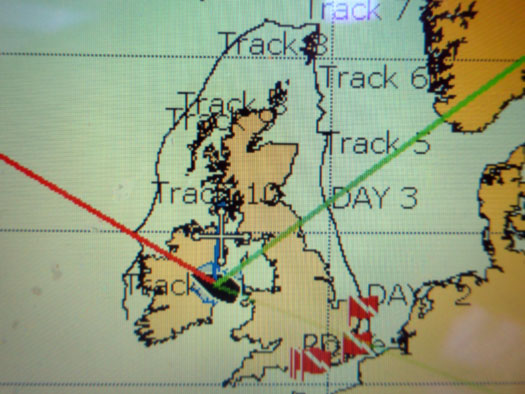
Moment of truth. The chart plotter's power dies just north of the Blaskets, the most westerly point of the 1802-mile course. Photo: W M Nixon

Getting on with it. Just south of the Blaskets, Brian goes aloft to try and clear the constantly-jamming Windex. Photo: W M Nixon
So they picked themeselves up, dusted themselves off, and started all over again. Brian went aloft to the waving masthead to free the Windex, which was in its jamming mood. Then progress was good heading down towards the Isle of Scilly. But even so, midway across, alone at the helm and steering and steering and steering, Liam admits to a very low moment.
They were now almost midway between Cowes and Dun Laoghaire, So he thought to himself: Why not just turn to port and head for home? Head for that comfortable NG34 berth in Dun Laoghaire marina, instead of struggling on with sails which were bound to shred even further, and leave them eventually straggling across the line completely dog last and with everything to fix, and then they'd have to turn round and plug into the early Autumn gales all the way back round Land's End to Dun Laoghaire?
And what then? he thought. Well, then in four years times we'll have to do the damned thing all over again. All, all, over again. So we'll just finish the bloody thing now, and get the T-Shirt, and that will be that regardless of how far we're placed behind everyone else, and good riddance to it all.
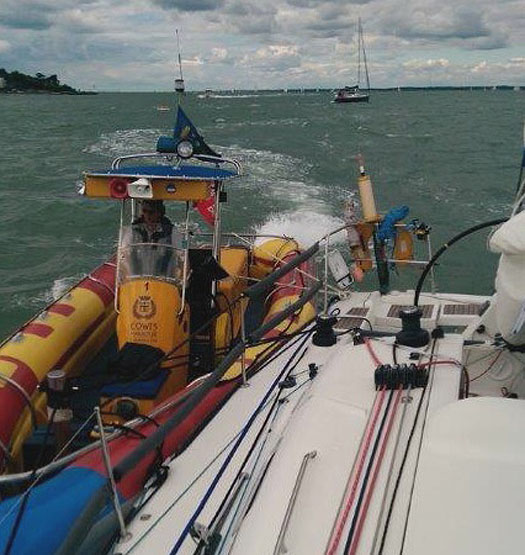
Welcome back. Knowing of Lula Belle's engine-less plight, the Cowes harbourmaster made sure they were brought into their Berth of Honour in style. Photo: Liam Coyne
So they stuck at it, they nursed the boat through the shipping separation zones at the Scillies without the spinnaker up because they knew the multiple gybing would destroy it, then as Rare didn't get past them until this stage, they knew that after such a long race she'd need to be 22 hours ahead at the finish and that was surely impossible. They were very much in with a shout of being better than last, so they nursed that mangled old spinnaker right up the English Channel (Mother Flahive's emergency sewing machine had done some marvellous repairs), and maybe the spreader ends were now showing out through the mainsail again, but what the hell, they got in round St Catherine's point and shaped their way back into the eastern Solent and on up to Cowes, and didn't Rare's crew and various bigwigs come out to tow them into port and confirm to them that they had indeed been there, they'd seen it, they'd done it, they'd won it., and now they could get the T-shirt.

Been there, seen it, done it, won it, got the T-shirt.....Liam Coyne back at the bar of the National YC five days after winning the two-handed division and two RORC classes in the 1802-mile Seven Stars Round Britain & Ireland Race 2014, and with his boat Lula Belle safely returned to her home port of Dun Laoghaire. Photo: W M Nixon
Round Ireland Yacht Race 2014 - The Fat Lady Sings
#roundireland14 – Can there be any ocean race of similar length that offers intrigue, excitement, drama, joy and despair to the same extent that the Round Ireland does?
What about the tight finish that saw only 7 minutes separating winner Tanit from Ruth in second place. How about Cavatina, much fancied before and after the start, on the water leader for 450 miles before fickle winds relegated her to a finish outside the top five. Think of the cruel luck of Amazing Grace, valiantly fighting back after a start line collision that cost her two hours of actual time and at least three more from missing the tide, only to break her boom when she had largely eliminated the deficit.
After recognising the great achievement of Richard Harris’ Clyde based Sydney 36 Tanit, much sympathy is reserved for Liam Shanahan and crew aboard the J109 Ruth. On Thursday morning we said “With only 45 miles to go at 4am, the forecast suggests that Ruth will enjoy a fairly steady breeze of medium strength for the final fetch to the finish.” Talk about putting the mockers on it! 4 hours later the wheels came off Ruth’s wagon and it took her 4.5 hours to cover 10 miles as the wind fell away. She still made a valiant effort to get across the line, missing out on overall honours by just 7 minutes after 5 days of racing.
Congratulations Tanit, deserved winners of the 2014 Round Ireland Yacht Race.
For those of us living the race vicariously, the Yellowbrick tracker has contributed enormously to our enjoyment so kudos to Wicklow Sailing Club and the RORC for its supply. Roll on 2016!
#roundireland14 – Richard Harris' Tanit, of the Serpent Yacht Club on the Clyde, has pipped Liam Shanahan's Ruth for the clubhouse lead in this year's incident-filled Round Ireland Race. Ruth looked all set to be the leader until a cruel combination of decreasing wind and increasing adverse tide held her up within sight of the Wicklow finish. Tanit, a Sydney 36, was safely in the club at this stage, knowing that any setback to Ruth's progress would establish them as the target boat for the rest of the fleet.
While there are boats yet to finish, Tanit is not guaranteed to be the overall winner, but as closest contender Cavatina, with a current VMG of 4 knots, needs to average over 6 knots for the remaining 70 miles, it looks likely that Tanit will be the name on this year's trophy.
Celebrations may be on hold for a while, as Cavatina has until just after 2am to reach Wicklow. It's not the forecast wind speed that will thwart Cavatin'a hopes for a threepeat, it's the direction of SSW that makes it a dead beat and thus requiring the extra distance through having to tack for the finish.
RoundIreland14 – It has been a classic Round Ireland Race. Just about everything except a gale, and even then there was some gear-breaking wind in the latter stages. But mostly, the sun shone. Or at least, there was little or no rain until Friday. And even if the wind didn't blow nearly enough, even those on the smaller boats who had committed a week's holiday time to this very special experience found they stayed within their leave limits, though only just.
When Wicklow farmer David Ryan confirmed in May that he had chartered the Volvo 70 Monster Project for the 2014 Round Ireland Race starting June 28th, he was succinct in his objectives. The bottom line was to support the Care For Shane campaign, which is raising funds for his nephew Shane Horgan, who was brain-damaged in a serious assault in 2012.
With the foundation of the plan in place, the details could be filled in. The Volvo 70 chosen was Russian, built in 2008 by Green Marine of Lymington. Owing to a shortage of funds during the race itself in 2008-2009, she didn't compete in all the legs. But once that race was over, here was this fine big Rob Humphreys design seeking a purpose, with time available to bring her up to standard. And she'd a new commercially-minded owner who cheerfully re-named the boat Monster Project, and worked on the basis of scouting out fresh fields for competition, as the Volvo World organisation was moving on to a new generation of boats in the next race.
But for round Ireland racing with fund-raising a priority, Monster Project ticked all the boxes. Nevertheless, Farmer Ryan was very realistic in his objectives. For sure, he hoped he might break the race's course record, which is a very different thing from the open round Ireland mono-hull record. But if he harboured even the slimmest hope of winning overall on corrected time, he kept it to himself. Yet he clearly stated that the main race objective was to win line honours – "first over the line for Shane". And at 18:25:25 hours on Wednesday July 2nd in a brisk southerly off the Wicklow pierheads with the enthusiastic support of the home crowd, Monster Project did that very thing.
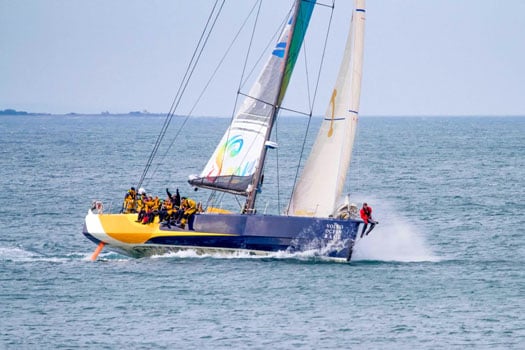
Job done. Monster Project takes line honours at Wicklow. Photo: Aidan Tarbett
As she was 70ft LOA and the next three biggest boats were "only" 60ft, it may have seemed a foregone conclusion. But the Round Ireland Race really is a case of swings and roundabouts and big dippers from time to time for every one of the 36 boats taking part. So though the Wicklow Monster may have built up a lead of 32 miles over the Open 60 Teng Tools Kilcullen (Eamon Crosbie & Enda O'Coineen) by the time she finished, she'd surely had to work for it. And had there been more fast off the wind stuff, things might have gone otherwise.
Despite the 10ft difference in length, the Open 60's potential is such that she rates an eye-watering 1.635 to the 1.6498 of Monster Project. So in rating terms the two boats were almost racing boat-for-boat, and in tactical terms that's the way Monster's 18-strong crew of all the talents had to see it.
But of course, with the predictions of light airs and calms for the first half of the week coming all too true, within 24 hours of the start it was becoming highly likely that one of the smaller boats would win, and low ratings became pearls beyond price. Observing it all and getting feedback from many sources, you became aware of the "Community of the Round Ireland Race" as the miles were slowly sailed. Their boats may have covered a wide variety of types and sizes, but the crews sharing this experience were joined together in a subtle way which gently but totally excluded outsiders.
You'd a sense of this in Wicklow as start time approached and the tension built up, with crews beginning to distance themselves from the shore crowds. Indeed, I got a blast of it in the car on the way down, listening to the Saturday morning's Down to Business programme on Newstalk, which is normally fronted by Bobby Kerr.
But as he was off to do the race on the fine big Farr 60 Newstalk for Adrenalin (chartered by Joe McDonald of the National YC), they'd a stand-in presenter. On the car radio, Kerr (a boat-owner himself) was trying to explain from the Farr 60 – with his usual zest – the special attractions of the Round Ireland Race to the American woman business journalist who was filling in for him in the studio. But he wasn't really making much progress. Her genuinely sceptical response to his enthusiasm for working coffee grinder winches and standing four hour watches 24 hours a day – and every chance of being called when you're off watch too – reminded me of the classic Bob Newhart sketch about the introduction of tobacco. The mutual incomprehension was just about total. And if Bobby Kerr can't explain the special attraction of racing round Ireland on his own radio show, then why do the rest of us even try?
The Round Ireland Race produces many imponderables. For instance, there's the matter of the new harbour and marina at Greystones finally hitting the headlines as a result of having Monster Project and Newstalk for Adrenalin based there in the leadup to the race, as Wicklow Harbour isn't really deep enough for them and both needed a pontoon berth.
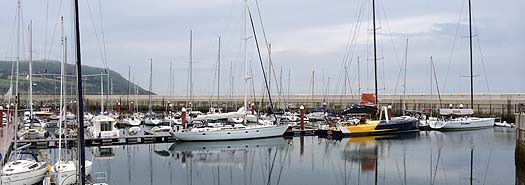
Arise, Greystones, and join the big time.....having Monster Project and Newstalk for Adrenalin in port pre-race raised Greystone's pofile something wonderful. Photo: Alan Corr
So Afloat.ie posted a pic from Alan Corr of Greystones Harbour showing the two biggies in port, and by sailing website standards it went viral. All because it's hashtagged #greystones. So be warned, in future you may find some very sleepy stories #greystones here on Afloat.ie if we hope to get them the Monster Newstalk level of attention.
But enough. Just as the sailor/spectator divide was beginning to manifest itself, I managed to get myself on board Wildwood for a quick recce. Not only was she the shortest entrant at just 30.5ft, but she was the newest with a build date of 2012. Yet in truth she was building since 2003, as this has been an extraordinary amateur design and build project, a case of good work done by stealth.
Though Wildwood sails from East Antrim Boat Club on Larne Lough, the first gleam of a notion came in the bar at Carrickfergus SC. Over a pint or three, amateur designer Richard McClure and can-do potential owner Ian Patterson sketched out ideas for a handy little dream performance cruiser-racer.
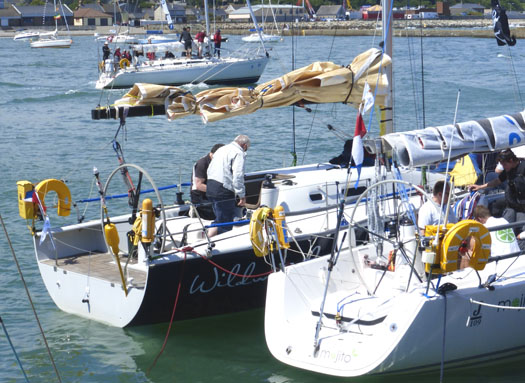
Little self-build 30-footer Wildwood (seen here outside the J/109 Mojito) came down from Larne to Wicklow for her first stab at the IRC big time. Photo: W M Nixon

Ian Patterson built Wildwood between 2003 and 2012, and they've won their class in the Scottish Three Peaks Race Photo: W M Nixon

Wildwood brought her shore support team – they came down from Larne with a couple of camper vans Photo: W M Nixon
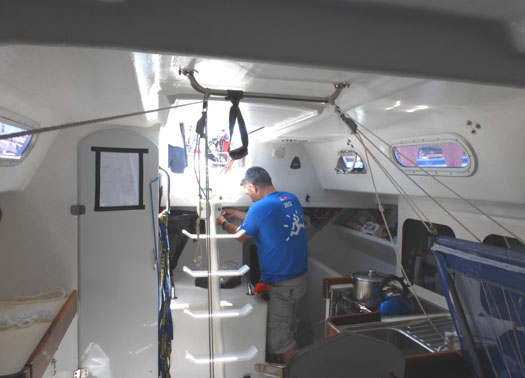
Below, Wildwood is roomy, with a highly individual layout Photo: W M Nixon

Wildwood has a substantial galley which wouldn't look out of place on a 40 footer. Photo: W M Nixon
It will be a good story to flesh out in more detail during the coming winter. Sufficient to say that she was launched in 2012 and arrived in Wicklow in June 2014 with honours already achieved by winning their class in last year's Scottish Three Peaks Race.
Nevertheless, despite the cheerful quayside support of family and friends who have stayed with the Wildwood project through its long gestation, the mood aboard was a bit subdued. The Scottish race had been on very basic handicaps, but the Round Ireland – which itself started in 1980 using a Wicklow modification of the ECHO system – is now part of the RORC programme, using strictly regulated IRC.
This new measurement routine put little Wildwood up from her notional rating of 1.02 to an official rating of 1.045. That may not seem like a huge jump, but for the crew of a little boat which prefers fast offwind stuff yet was going out to face a long beat right up Ireland's long Atlantic seaboard, it seemed like yet another mountain to climb.
But out they all go for the start, these 36 boats in all shapes and sizes, and any crewmember who denies abdominal butterflies at this time is either in denial, or so full of Stugeron they don't know what's going on below their navel.
With a decent nor'east breeze and a sluicing ebb running south, it's a tricky close reaching start at 1400 hours, but Teng Tools Kilcullen and serial overall winner Cavatina (Ian Hickey) are right there on time, and the only shunt in the body of the fleet is between western boats Lynx Clipper (Galway) and E F Collins/Amazing Grace (Tralee), with the latter returning to port to fix a fist-sized hole in her stern and set out again after some hours with a post-race protest in the offing.
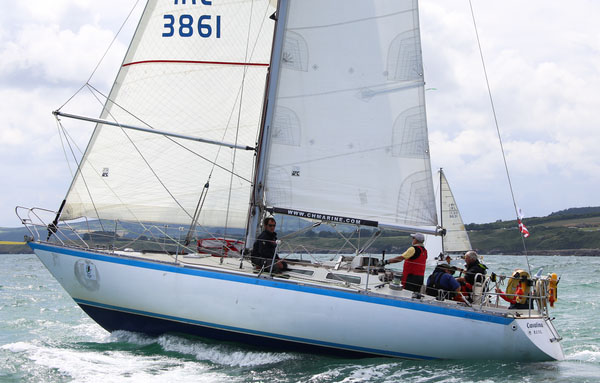
Out of the ruck of the start, the little Cavatina showed well among a raft of larger boats. Photo: David O'Brien
Coming out of the start, with boats which would emerge as performers as the race went on starting to show themselves. The Sydney 36 Tanit is left foreground, the Rodman JV 42 Phosphorus (Mark Emerson) is making hay with Code 0, the "steady Eddy" Ker 39 Inis Mor is right front, and the big Farr 60 Newstalk for Adrenalin is starting to show a performance which just kept getting better throughout the race. Photo: W M Nixon
Thanks to the Yellowbrick plotters, following the fleet has become like a computer game. If you're bored with the progress, you can always accelerate them electronically up and down along the course, with it all becoming – as the less reverent have remarked – like a pack of rats trying to get up a drainpipe.
It's when you see it reduced to symbols on a screen in the big picture that you realise how restrictive the round Ireland is for epic tactical gambles. In the Newport-Bermuda race, for instance, the 600 miles of straight line across the open ocean provides a broad canvas, and the famous Carina once notched one of her legendary wins by being all of 60 miles to the westward of the rhumb line. But in the round Ireland, only along the south coast is there a decent option for taking a real flyer, and it was there south of Youghal that Teng Tools went offshore as the wind drew sou'westerly, while the nearby and faster-to-windward Monster Project went off to close the land and cover the French Volvo 60 Libertalia and Newstalk for Adrenalin.
Monster put those two well away, but at the Fastnet she was only 20 minutes ahead of Teng Tools Kilcullen shortly after noon on Sunday, TTK coming sweetly in from seaward and doing very well in conditions which didn't really suit her at all.

Teng Tools Kilcullen at the Fastnet 21.5 hours after the start. Photo: Paul O'Flynn
In fact, if you'd set out to design a race which didn't at all suit an Open 60, then the 2014 Round Ireland would be in the top five. An awful lot of light windward work, and gates at every turn. In these conditions, a Volvo 70 is more flexible, but even so on Tuesday as Monster sat stopped off Inishtrahull, TTK was close to the southwest and energetically tacking inshore along the north coast of Donegal against a local easterly, keeping herself well in touch.
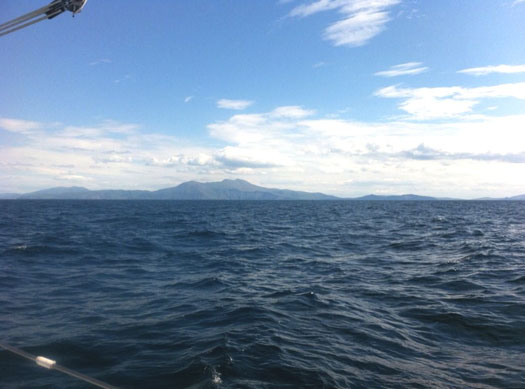
Fine day out west – the Kerry coast with the Blaskets as seen from Liam Shanahan's J/109 Ruth

Good morning, Ireland. The Scottish Sydney 36 Tanit (Richard Harris) enjoys a summer sunrise on the Atlantic coast, even if they do have to turn to windward. Photo: Roisin Harris

Even with all June's sunshine, the North Atlantic was distinctly chilly for this swim from the First 40 Arthur Logic

Downtime on the Sydney 36 Tanit out in the Atlantic. Owner Richard Harris sails under the burgee of the Serpent YC, a Scottish club founded in 1976 for sailing health professionals. Photo: Roisin Harris
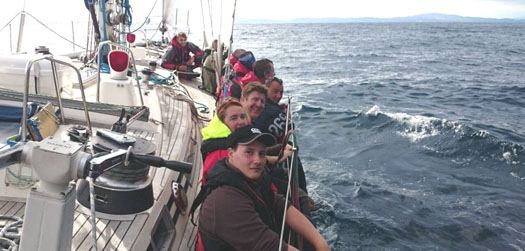
All hands to the lee rail to get a bit of heel on the hefty Swan 57 Bow Waves Racing from Galway as she makes slowly to windward off the Atlantic coast.
The two biggest boats then had an awful lot of hard work tacking through the North Channel, but astern Newstalk was getting into the groove, and by the time Monster was finishing the Farr 60 had seen off the Volvo Ocean 60, and was giving TTK a bad time.
With the new southerly filling in with gusto, the little boats still off the Donegal coast were making hay, with Cavatina coming in round Tory Island well up with the Swan 57 Bow Waves from Galway. Cavatina's crew were having the time of their lives and living well with it – they tweeted the cooking spuds which power the boat, presumably with buckets of Barry's tea. However, until Donegal the talking point had been the impressive game of catch-up being played by Brian O'Sullivan and his Tralee Bay crew in the Oyster 37 E F Collins/Amazing Grace, as they were ninth overall in IRC at one stage, and of course if their protest was upheld post-race, Heaven only knows what compensatory time would be added.
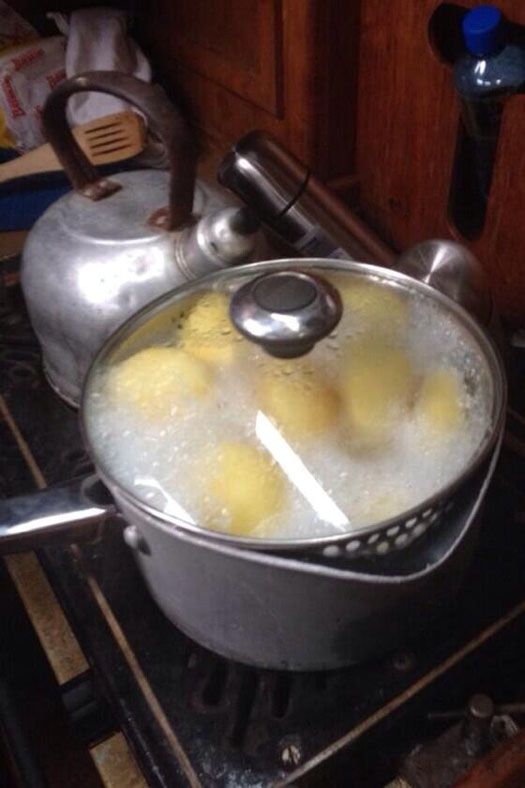
Grub up! In many years of successful Round Ireland racing, Cavatina's crew have learned the importance of feeding the inner man.
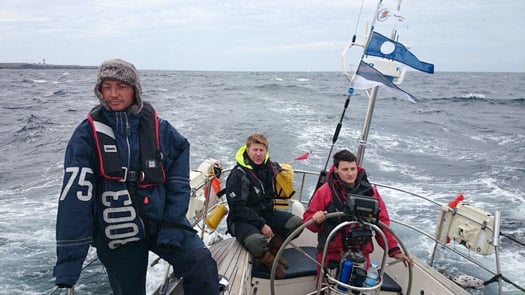
The brisk new sou'wester brought the Swan 57 Bow Waves Racing sweeping in past Tory Island, but she'd the much-smaller Cavatina in sight astern.
But that spirited performance ended with a bang on Wednesday with a broken mainboom which, together with other problems, led to their withdrawal. However, there were plenty of others to take their place in challenging for the overall lead, with Liam Shanahan and his crew from the National YC in the J/109 Ruth getting themselves firmly ahead of Frank Doyle's A 35 Endgame from Cork, while the attractive Sydney 36 Tanit from Scotland was also very much in the running.
Looking at the fleet overall as they made along the Donegal coast, there were discernible patterns emerging, with boats you'd call the "solid performers" starring on the track chart. These were boats such as Inis Mor, Tanit and Ruth which always seemed to be there or thereabouts, always plugging away and showing a clean pair of heels to the nearest-rated boats, and always well placed such that if local wind and tide conditions favoured them, they were poised to ascend rapidly to the top of the leaderboard.
As for the "sail training" vessels, in the closing stages the Jeanneau Sunfast 37 Desert Star of Irish Offshore Sailing at one stage on Wednesday found herself lying second overall to Cavatina. But with 170 miles still to go, and most of them to windward, it was going to be hard work for a keen multicultural crew of many nationalities to maintain this exalted placing.
It was Thursday morning which was crunch time. Having filled in from the south, there was a brief period in which the wind veered towards the west, and with Monster Project well finished and then Teng Tools Kilcullen, Newstalk for Adrenalin and Libertalia finishing during the night, first light saw the steady and reliable Inis Mor finishing at 04:13:56 to stake a claim which was challenged by boats such as Tanit and Ruth closing up from astern in a now-favourable tide, the tide having been against Inis Mor all the way down from Rockabill except for the last hour or so.
The challenge from a hundred miles away of Cavatina faded for a while with light airs off Belfast Lough and a foul tide in the North Channel. But in the south end of the Irish Sea and through St George's Channel, the sou'west to west breeze was holding enough to have Tanit and Ruth moving theoretically into the top slots ahead of Inis Mor. But then with the tide turning again to run north around 0900 hrs, it was to be nail biting stuff through Thursday morning.
Tanit was in by 10:00:44 hrs on Thursday, leaving the lower-rated Ruth with a mountain to climb, the tide against her and the breeze light. It was excruciating to follow, with her speed down at times to barely a knot over the ground off Greystones, and the lovely Wicklow coastline just crawling past at snail's pace. Meanwhile, far astern Cavatina was back in business with just 80 miles to sail, and a local breeze giving her better than 5 knots on the clock.
Meanwhile by 1300hrs Ruth had just 5 miles to go, and speed slowly building as the wind was generating around big clouds over Dublin.
But by just after 2pm Thursday it was clear Tanit had pipped Ruth for the clubhouse lead. Ruth had looked all set to be the leader until a cruel combination of decreasing wind and increasing adverse tide held her up within sight of the Wicklow finish. Tanit, safely in the club, knew that any setback to Ruth's progress would establish them as the target boat for the rest of the fleet. Wicklow Sailing Club could not formally announce the winner until much later on Friday as the last of the boatts finished but it was clear not even Cavatina who had until 2am on Friday could match the time of the Scottish Sydney 36.
They and all the other competitors will have this weekend to decompress and try to explain to family, friends and workmates just what this crazy Round Ireland Race thing is all about. But it isn't until the great prize giving dinner in Wicklow in the Autumn that they can all really tell the stories that just have to be told, and tell them to people who will really understand.
#roundireland14 – Round Ireland races have many twists and turns before a winner can be declared and this one is living up to this reputation. Earlier this morning it looked like Ruth was going to romp home in a decent breeze to victory. The wind and tide had other ideas and now Ruth is looking at the finish line, but from the course side, not from the comfort of the Wicklow Sailing Club Bar.
It looks like Ruth could well be denied the overall wind by the combination of light winds and a foul tide as she languishes off Kilcoole, just 7 miles from the finish. If the breeze doesn’t pick up, Tanit, the clubhouse leader, will be looking pretty, unless, and there is always a caveat, a freshening and veering breeze sweeps the smaller boats down the Irish Sea. This would put long time on the water leader Cavatina back into the mix.
There is a slight hope for Ruth – the flood tide is easing off and there is a small increase in the breeze. If she can average 6 knots and get to Wicklow by 13:53. Tight, but possible.
Next report in an hour.
Round Ireland (Thursday Dawn) - National YC's Ruth Now Favourite as Cavatina Falls Foul of Wind and Tide
#roundireland14 – In a dramatic change of fortune for the long time Round Ireland Race favourite Cavatina, Liam Shanhan's Ruth, a J/109 class yacht from the National Yacht Club, has taken over as the main contender for the overall prize in this year's Round Ireland race. Cavatina, along with many of the lower rated yachts has sailed in to a calm patch off Belfast Lough and as a result has lost any benefit gained from a favourable tide in the North Channel. With only 45 miles to go at 4am, the forecast suggests that Ruth will enjoy a fairly steady breeze of medium strength for the final fetch to the finish, while those astern will encounter less favourable winds in the last stretch down the Irish Sea.
The effect on Afloat's race predictor is remarkable. None of the lower rated boats feature in the latest prediction, as the 16 knots that Ruth is experiencing now appears to diminish in her wake, effectively creating a block behind her that will hinder the chasing boats. This will favour those boats ahead of Ruth that have finished or will finish before 10am.
So now the final Round Ireland 2014 result might look something like this:
1. Ruth
2. Tanit
3 Inis Mor
4. Fujitsu
5 Phosphorous
6 Arwen
Afloat hesitates to predict beyond this - there may be some surprises left in this race yet.
Click this link for all our RoundIreland2014 coverage
#roundireland14 – There were homecoming celebrations tonight for 2014 Round Ireland Race line honours winner David Ryan and his chartered Monster Projects Volvo 70 when they crossed the Wicklow finish. His clubhouse lead will, however, be shortlived, as light winds since last Saturday's start have allowed smaller, lower rated boats, currently racing down the east coast, to take a significant advantage for the overall handicap prize. We predict the overall finishing positions below.
The stretch of water that links the northern Irish Sea to the Atlantic Ocean is called the North Channel and the constriction of the water between Ireland and Scotland gives rise to some fairly significant flows, particularly around Rathlin Island. At springs, there can be in excess of 4 knots of tide on the north Antrim coast along with considerable overfalls. Consequently, were one not racing, the prudent southbound mariner would time his or her arrival at the eastern tip of Rathlin to coincide with low water Dover to not only get the benefit of six hours of south-going flood stream but also to avoid the rough water caused by the overfalls.
In this year's Round Ireland Race already there have been winners and losers. Newstalk for Adrenalin averaged 6.3 knots for this stretch, while Inis Mor, just a few hours later, averaged 7.8 knots.
At 2000 BST just 2 hours before LW Dover, Cavatina has just rounded Rathlin’s eastern tip. Although not ideal for avoiding overfalls and a couple of hour short of optimal, she is going to get about eight “free” miles from the tide, equal to one hour of elapsed time and perhaps an hour and five minutes of corrected time. It’s not only Cavatina who benefits from this tidal cycle, Leopard Clipper and Wild Spirit, immediately behind Cavatina, should get a good push as well. Up ahead, Muskox, Bow Waves Racing and McGregor IV are also in a good tidal position. However, it’s not looking so good for Big Deal, currently trying duck the adverse tide off Portrush, who look likely to suffer from being somewhat out of sync, tidally speaking.
This push will be a real boost to Cavatina who may well need it. Closest rival is now Liam Shanahan’s Ruth some 50 miles further along the track. However Ruth may well benefit from a slight but temporary veering of the wind which may change a beat to the finish to a fetch, while it currently looks like Cavatina will have it on the nose.
Afloat’s current prediction (2000hrs on Wednesday, July 2):
1. Cavatina
2. Ruth
3. IOS - Desert Star
4. Tanit
5. McGregor IV
6. Polished Manx
7. Big Deal
8. Dreamcatcher
9. Endgame
10. Muskox
Click this link for all Afloat's RoundIreland2014 coverage
#roundireland14 – The 2014 Round Ireland Race is approaching endgame as Monster Project enters the North Channel with less than 150 miles to go. Half a country away to the west, the prospect of an increasing and following breeze overnight must be a welcome relief to the crews of those boats that have been looking at the Mullet peninsula for the best part of twelve hours. The forecast suggests that, once again, the big boys will be severely disadvantaged by the repeating meteorological pattern of a wind dying from ahead and filling in from behind. So while the large vessels encounter head winds of not much more than 10 knots, the IRC 3 and IRC 4 yachts will enjoy 15 knots plus of following breeze.
The boats are now generally following the rhumb line so it’s all about squeezing every bit of boat speed out of sail and boat trim, giving the tacticians a much needed brain rest.
Predicting the overall result at this stage is akin to sticking a pin in the entry list, but Afloat has developed a very sophisticated algorithm over the years that has indicated the boats that are likely to be in the mix on corrected time at the finish.
Currently, our top ten looks like this:
1. Cavatina
2. Polished Manx
3. Big Deal (Sponsored by Union Chandlery)
4. Eugene F Collins/Amazing Grace
5. Tanit
6. Ocean Tango
7. IOS Desert Star
8. Dreamcatcher
9. McGregor IV
10. Ruth
With many miles to go, this list will be much refined before the winner emerges and much will depend on the positioning at the tidal gates of the North Channel.
Click this link for all Afloat's RoundIreland2014 coverage
For the first time since the Round Ireland Race start on Saturday, Cavatina does not feature on the leaderboard. Not that Ian Hickey and his team have eased the pressure on his competitors, but it appears that a combination of tacking offshore and a too literal interpretation of the course by the tracking system suggests that Cavatina has further to go than some of her inshore rivals. Before looking at tactics, lets explain the course line issue. The Yellowbrick prediction system works on the distance to go represented by the course line as drawn on the virtual map. Dividing the distance to go by the boat's VMG and multiplying by the time correction factor predicts the corrected time for the race and thus allows a predicted finishing order. However, if, as in this case, the course line does not actually track the rhumb line, then distortion occurs. The actual rhumbline across Donegal Bay is directly from Black Rock lighthouse to Tory Island, but for some reason the tracking system follows the coast more closely, suggesting that the course dips into Donegal Bay, adding distance. thus the boats that stay closer to the rhumb line may appear to have a shorter remaining distance.
The conclusion from all this is not to place too much faith in the tracker, but to look at it in association with the analyses by the pundits, as the tracker will not take into account the wind and tidal conditions.
We have a really close and exciting battle ahead (but only slowly evolving) as the fleet approaches the north coast and the tidal minefield that is the North Channel. Sydney 36 Tanit is now the IRC leader, just ahead of 2012 winner Inis Mor, and these two boats are benefitting from a light patch of wind currently blanketing the chasing pack.
Just going to cover my eyes for a while!! #RoundIreland14 pic.twitter.com/sEZm3U75Yp
— Cavatina Irl3861 (@cavatinaireland) July 1, 2014
#roundireland14 – The Yellowbrick race trackers installed on the Round Ireland fleet afford the armchair viewers the luxury of slow motion replays. As the wind headed the boats on the approach to the Galway coast some made the decision to stay on starboard tack, seeking stronger breeze to the west of the rhumbline away from the coast, while competitors tacked on the header and moved inshore or short tacked along the rhumb line. Boats that were next to each other at Loop Head diverged and are now converging off the Mayo coast.
The tracker's replay facility allows us to rewind the race and analyse the distance gained or lost by the inshore/offshore decison. When the comparison is between sister ships it is more valid as the one-design qualities negate the differences in speed. Thus we can compare the tracks of Persistance and State of Chassis, two almost equally rated Sigma 38s. At 1144 Monday, the boats were 1.4 miles apart as they rounded the Blaskets with State of Chassis ahead.
Fast forward to 2000 and Persistance has gained somewhat by staying closer to the rhumbline slightly east of State of Chassis. At that time Persistance tacks towards the coast, while SoC continues on starboard out to sea. At 0200 Tuesday, SoC tacks back towards the coast, but at this stage is some 20 miles to the west of Persistence who has short tacked close to the rhumbline.
Imagine SoC's disgust when at 0430, Persistance crosses her bow at a distance of about 6 miles having gained 7.4miles over the previous 12 hours.
This tactical battle is being played out across the bulk of the fleet, although the inshore option has been chosen by the greater number of boats. This may change as the fleet crosses Donegal Bay. Cavatina still leads, but the minor places are fluctuating. Amazing Grace's catch up continues - now up to 13th overall on IRC.



























